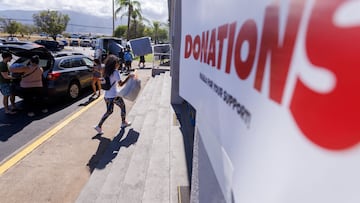How to avoid scams if you want to donate money to the victims of the wildfires in Hawaii
Wildfires have ravaged Hawaii and people on the island need help rebuilding their lives. Make sure you avoid scams when trying to donate to their cause.


The devastating wildfires in Hawaii have killed more than a hundred people and left thousands homeless, and also razed businesses and historical sites to the ground.
The fires that began on Aug. 8 are considered the deadliest natural disaster in the history of the state, and locals need as much help as they can to recover from the tragedy.
Many people want to help, but unfortunately, there are others who take advantage of the situation by setting up schemes to scam potential donors. Make sure that the assistance that you want to provide goes into the hands of those who are truly in need, whether you want to help the victims of the Hawaii wildfires or contribute to any other charitable cause.
Here are some steps you could take to avoid scams.
Research the organization
Before making a donation, research the organization thoroughly. Check their official website, social media profiles, and any news articles about their disaster relief efforts. Make sure they are a reputable and established organization.
Use official websites for transactions
Only donate through the official website of the charity or organization. Avoid clicking on links in emails or social media posts, as these could lead to fake websites designed to steal your information.
Secure payment methods
When donating online, ensure that the payment process is secure. Look for “https” in the website’s URL and check for a padlock symbol in the browser’s address bar.
READ ALSO: What are the 4 types of tropical storms?
Make your donation traceable
Do not donate using a wire transfer, gift card, or cryptocurrency, all of which are difficult to trace if something goes wrong. Avoid sending money via payment apps like Venmo or Zelle, as it would be difficult to recover your money once the other party receives it. According to the Federal Trade Commission, the best way to give money is through a credit card or a check.
Verify charity status
Confirm that the charity is registered as a nonprofit organization with the relevant government authorities. In the United States, you can use tools like the IRS’s Tax Exempt Organization Search to verify their status.
Relief organizations in Hawaii are asking for donations and volunteers as Maui wildfires push Lahaina residents to shelters.
— The Washington Post (@washingtonpost) August 10, 2023
Here's how you can help: https://t.co/LVsBkoTGt9 pic.twitter.com/6h71oMaSM7
READ ALSO: What is the difference between a typhoon and a hurricane?
Check for transparency
Legitimate charities are usually transparent about their use of funds. Look for information on their website about how donations are used and the impact they’ve had on disaster relief efforts.
Contact the organization directly
If you’re unsure about an organization, contact them directly using contact information from their official website. Ask questions about their work, how they allocate donations, and what specific disaster relief efforts they are involved in.
Be wary of high-pressure tactics
Scammers often use high-pressure tactics to get you to donate quickly without thinking. Legitimate organizations will allow you time to research and make an informed decision.
Check for reviews and ratings
Look for reviews and ratings of the organization on reputable websites like Charity Navigator, BBB Wise Giving Alliance, and GuideStar. These platforms provide insights into the organization’s financial health and accountability.
Keep records
Related stories
After making a donation, keep a record of your donation receipt, including transaction details and confirmation emails. This can be useful for tax purposes and as proof of your donation.
Consider established organizations
Opt for well-known and established organizations with a history of disaster relief efforts. These organizations are more likely to have the infrastructure in place to effectively deliver aid.

